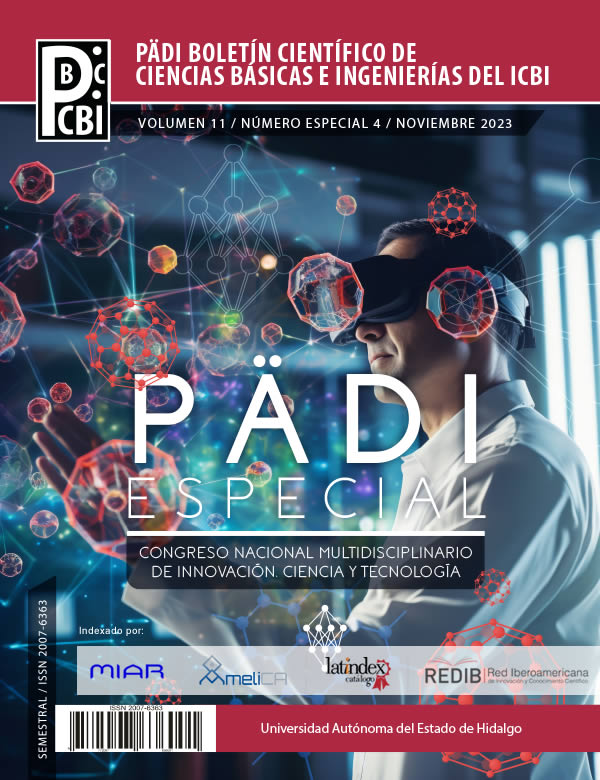Neural networks modelling of the upper limb neuromusculoskeletal system
Abstract
This manuscript describes the development of a non-parametric model using an identification algorithm using a differential neural network (DNN). The training process is carried out using the data obtained from the U-LIMB database, from which the input and output signals are obtained, which correspond to the electromyography signals and the movement trajectories, respectively. Using the data above, the stability-based Lyapunov learning laws adapt the weights that adjust the RND. Once the DNN has been trained, a model capable of online mapping electromyography signals in their corresponding angular trajectory shown by an inverse kinematics process is obtained. Once the simulation has been carried out using a virtual upper limb model, the use of the identified angular trajectories is discovered using a derived proportional control that guarantees the trajectory tracking of the virtual arm in relation to specific EMG signals entering the DNN.
Downloads
References
Alfaro-Ponce, M. y Chairez, I. (2020). Continuous and recurrent pattern dynamic neural networks recognition of electrophysiological signals. Biomedical Signal Processing and Control, 57:101783.
Averta, G., Barontini, F., Catrambone, V., Haddadin, S., Handjaras, G., Held, J. P., Hu, T., Jakubowitz, E., Kanzler, C. M., y Kühn, Johannes, t. (2021). Ulimb: A multi-modal, multi-center database on arm motion control in healthy and post-stroke conditions. GigaScience, 10(6).
Ayala, H. V. H., Habineza, D., Rakotondrabe, M., y dos Santos Coelho, L. (2020). Nonlinear black-box system identification through coevolutionary algorithms and radial basis function artificial neural networks. Applied Soft Computing, 87:105990.
Azhiri, R. B., Esmaeili, M., y Nourani, M. (2021). Real-time emg signal classification via recurrent neural networks. En 2021 IEEE International Conference on Bioinformatics and Biomedicine (BIBM), pp. 2628–2635. IEEE.
Berning, J., Francisco, G. E., Chang, S.-H., Fregly, B. J., y O’Malley, M. K. (2021). Myoelectric control and neuromusculoskeletal modeling: Complementary technologies for rehabilitation robotics. Current Opinion in Biomedical Engineering, 19:100313.
Chen, J. y Qiao, H. (2020). Muscle-synergies-based neuromuscular control for motion learning and generalization of a musculoskeletal system. IEEE Transactions on Systems, Man, and Cybernetics: Systems, 51(6):3993–4006.
Cotter, N. E. (1990). The Stone-Weierstrass theorem and its application to neural networks. IEEE Transactions on Neural Network, 1:290–295.
Cybenko, G. (1989). Approximation by Superpositions of a Sigmoidal Function. Mathematics of control, signals and systems, 2(4):303–314.
De Groote, F. y Falisse, A. (2021). Perspective on musculoskeletal modelling and predictive simulations of human movement to assess the neuromechanics of gait. Proceedings of the Royal Society B, 288(1946):20202432.
Foroutannia, A., Akbarzadeh-T, M.-R., Akbarzadeh, A., y Tahamipour-Z, S. M. (2023). Adaptive fuzzy impedance control of exoskeleton robots with electromyography based convolutional neural networks for human intended trajectory estimation. Mechatronics, 91:102952.
Khalifa, Y., Mandic, D., y Sejdi´c, E. (2021). A review of hidden markov models and recurrent neural networks for event detection and localization in biomedical signals. Information Fusion, 69:52–72.
Khalil, H. K. (2015). Nonlinear control, volumen 406. Pearson New York.
Lozano, A., Ballesteros, M., Cruz-Ortiz, D., y Chairez, I. (2022). Active neck orthosis for musculoskeletal cervical disorders rehabilitation using a parallel mini-robotic device. Control Engineering Practice, 128:105312.
Lynn, H. M., Pan, S. B., y Kim, P. (2019). A deep bidirectional gru network model for biometric electrocardiogram classification based on recurrent neural networks. IEEE Access, 7:145395–145405.
Muñoz, M. P. B. y Rodarte, I. T. (2019). Estudio cualitativo de la discapacidad en México: Una perspectiva familiar.
Nelles, O. (2020). Nonlinear system identification: from classical approaches to neural networks, fuzzy models, and gaussian processes. Springer Nature.
Olsson, F., Halvorsen, K., y Åberg, A. C. (2021). Neuromuscular controller models for quantifying standing balance in older people: A systematic review. IEEE Reviews in Biomedical Engineering, 16:560–578.
Poznyak, A. (2008). Advanced Mathematical Tools for Automatic Control Engineers: Volume 1: Deterministic Systems, volumen 1. Elsevier Science.
Poznyak, A. S., Sanchez, E. N., y Yu, W. (2001). Differential neural networks for robust nonlinear control: identification, state estimation and trajectory tracking. World Scientific.
Roy, S., Kiral-Kornek, I., y Harrer, S. (2019). Chrononet: a deep recurrent neural network for abnormal eeg identification. En Artificial Intelligence in Medicine: 17th Conference on Artificial Intelligence in Medicine, AIME 2019,
Poznan, Poland, June 26–29, 2019, Proceedings 17, pp. 47–56. Springer.
Spong, M. W., Hutchinson, S., y Vidyasagar, M. (2020). Robot modeling and control. John Wiley & Sons.
Xie, Y. Y. y Djurdjanovic, D. (2021). Monitoring of human neuromusculoskeletal system performance through model-based fusion of electromyogram signals and kinematic/dynamic variables. Structural Health Monitoring, 20(3):804–817.
Xu, S., Wang, Z., Sun, J., Zhang, Z., Wu, Z., Yang, T., Xue, G., y Cheng, C. (2020). Using a deep recurrent neural network with eeg signal to detect parkinson’s disease. Annals of translational medicine, 8(14).
Zhou, J., Dong, L., Guan, W., y Yan, J. (2019). Impact load identification of nonlinear structures using deep recurrent neural network. Mechanical Systems and Signal Processing, 133:106292.
Copyright (c) 2023 Ulises Villela-Zúñiga, Manuela Gómez-Correa, Mariana Felisa Ballesteros-Escamilla, David Cruz-Ortiz, Iván de Jesús Salgado-Ramos

This work is licensed under a Creative Commons Attribution-NonCommercial-NoDerivatives 4.0 International License.













